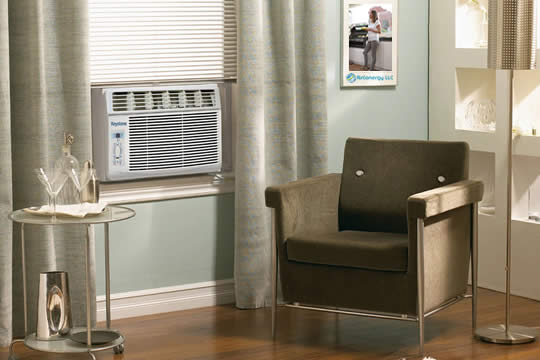Self Contained Air Conditioner: What Options Are There?
With the growing demand for fully self contained air conditioner units to keep people cool during summer, there seems to be more variety than ever on sale in stores and online.
If you are not sure what is meant by "self contained," when describing air conditioning equipment, this article will explain the various types.
I'll concentrate on the two main types commonly found in homes, short-term living quarters such as hotels or motels, hospitals and care centers, etc. and their advantages and disadvantages. These are divided into floor-mounted, window-mounted and free standing units.
 The simple definition of self contained AC is a single unit containing all the refrigeration processes that take the warm air from a space and return cool air in its place.
The simple definition of self contained AC is a single unit containing all the refrigeration processes that take the warm air from a space and return cool air in its place.
Portable Air Conditioners
Let's start with the lowest cost and easiest to install self contained AC units, which are the ever popular portable air conditioning units.
Free standing air conditioners come in a range of sizes and power outputs to cope with a variety of room sizes and cooling applications. Basic, low powered models are ideal for spot cooling or dealing with small rooms that would otherwise be too hot and sticky in summer to be used comfortably.
Larger, dual hose models can cope with larger rooms and some fully self evaporating portable air conditioners have the capability to recycle and remove condensate, eliminating the need to periodically empty a catchment tray or container.
There are also smart portable air conditioners that are WiFi ready and can be controlled via a phone app or voice activated home assistant.
Often confused with true refrigerant-based coolers are the evaporative coolers, often referred to as "ventless portable air conditioners." These create cold air by evaporating moisture then fanning it into the room and are not true air conditioning units.
Taking a step up from a portable or free standing, self-contained air conditioner and its portability as its main attractive feature is the fixed cooling unit known as the window air conditioner.
Window Air Conditioners
These self-contained cooling units are installed in a window opening, giving them their name.
Window AC units also come in a variety of power output options, to cater for the needs of the homeowner and the size of the space to be cooled down.
PTAC (Package Terminal Air Conditioners)
Similar in appearance to window units are the self-contained package terminal air conditioners.
What makes these different from window units is they do not need to be installed in a window opening. They are generally installed below a window on an external wall, needing a vent opening to be created in the wall to allow for the exhaust of hot moist air.
PTAC units are mostly found in hotel and motel rooms rather than in homes as they are best suited to buildings with multiple individually occupied rooms.
Packaged air conditioner units, also referred to as an all-in-one or self-contained cooling systems are also typically used for mobile home, rental apartment, condo or other commercial applications. What differentiates them from split air conditioners is that packaged air conditioners contain all the main operating components inside a single unit that can be located inside or completely outside the living space.
The condenser coils, compressor and evaporator are literally "packaged" into a single unit. PTACS can also be located on the roof of buildings . These are then known roof top AC units.
It is also worth noting that some self-contained air conditioners can also include electric heating coils or a heat pump arrangement to provide heat during cold weather.
VTAC (Vertical Terminal Air Conditioners)
An alternative design of PTAC is the vertical terminal air conditioner.
It is still a self contained cooling unit but instead of being located beneath a window or low down on an external wall, a VTAC is designed to fit vertically into a narrow, tall enclosed space. This could be a convenient closet or custom-fitted narrow cupboard to make the room look more comfortable with cleaner lines.
Conclusion
The design benefit of self-contained systems is that they help to save space within a home or a business premises. Its installation costs are generally cheaper since less area is covered.
As a general rule, the SEER rating of many self contained AC units is typically measured between 13 to 18. These units also provide a unique ventilation solution in high-rise buildings located in urban areas.
![]()

